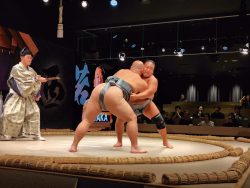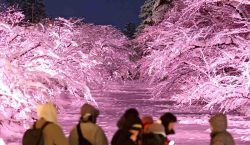
Visitors look at the permanent exhibition at the Fukui Prefectural Dinosaur Museum in Katsuyama, Fukui Prefecture.
12:14 JST, August 12, 2023
FUKUI — Fukui Prefecture, which is the center of dinosaur research in Japan due to the discovery of many fossils in the area, is increasing efforts to attract more tourists, highlighted by the reopening of the Fukui Prefectural Dinosaur Museum in Katsuyama.
The museum reopened in July with new facilities and renewed attractions, with about 18,000 visitors in the first three days. Both children and adults greatly enjoyed the hands-on programs that were expanded through the renovations.
Since opening in 2000, the dinosaur museum has been popular due to its permanent exhibits of dinosaur fossils and elaborately reconstructed skeletons, attracting a total of over 12 million visitors and ranking among the most visited natural history museums in Japan.

Visitors lining up in front of the museum just before reopening
One of the museum’s attractions is the Field Station, a dinosaur fossil excavation site located about 20 minutes from the museum by bus. There are guided tours which are particularly popular as participants can break open rocks at the site and experience the process of discovering and identifying dinosaur fossils. However, the Field Station closes during the winter, unable to secure a stable number of visitors throughout the year.
The prefectural government temporarily closed the museum from December last year. The museum underwent a major renovation at a cost of about ¥9.4 billion so the facility could allow visitors to experience fossil excavation year-round.
Hands-on programs
About 80% of dinosaur fossils discovered in Japan are from Fukui Prefecture. The reopened dinosaur museum has new exhibits demonstrating its forefront of dinosaur research — the dinosaur tower.

The Dinosaur Tower in the new annex
A geological feature called the Tetori Group, a stratigraphic group dating from the Jurassic to the Cretaceous, is located near the museum. Full-scale excavations have been conducted since 1989, with many dinosaur species and small dinosaur tooth fossils being unearthed. The tower, about 13 meters high, has life-size models of five dinosaurs, including Fukuivenator and Fukuisaurus, and one avian species, found in these excavations.
A fossil research training area has been set up in the new annex where visitors can simulate an excavation process even when the field station closes during the winter. There is a section for assembling a Tyrannosaurus fossil replica, as well as a hands-on fossil unearthing program. Using a tool, each participant scrapes an artificial stone to reveal a replica made with resin, of a Fukuiraptor tooth fossil. The process of removing the stone matrix covering the fossil replica is close to researchers’ actual work. Participants use a pen-shaped tool, also used in research, that has a tip vibrated by air pressure to cut into the stone.

An artificial stone is scraped using special tool for extracting a fossil replica.
After carefully scraping the surface of the white artificial stone, a black fossil is seen. “I didn’t know such detailed work is necessary to find fossils,” a visitor said with surprise. The participants can take the fossil replicas home.
“We have prepared the program to be very similar to the work by professionals as we want visitors to experience real research,” said Kazuo Terada, head of the museum’s research and exhibition department. “I believe only at our dinosaur museum can you have such an authentic experience.”
The permanent exhibits have also been enhanced with its reopening. A mummified fossil of the herbivorous dinosaur Brachylophosaurus has been added to the exhibits. The 3.2-meter-long fossil has well-preserved bits of skin. The number of complete dinosaur skeletons has also been increased to 50 compared to 44 in December last year.
“I’m certain the reopened museum is enjoyable even for people who have come here before,” Terada said.
Shinkansen expected to bring more visitors

The Fukui prefectural government is expecting to receive more visitors from the Tokyo metropolitan area. Before its reopening, about 60% of the visitors to the Fukui Prefectural Dinosaur Museum came from the Kansai and Chukyo regions — Nagoya and the surrounding area — and only about 15% of them were from the Tokyo metropolitan area.
The Hokuriku Shinkansen bullet train line will be extended to Tsuruga, Fukui Prefecture, from next spring, and trains will stop at Fukui Station. As the extension makes Fukui more accessible from Tokyo, prefectural officials think it is a golden opportunity to have its appeal as a tourist destination widely known.
“I hope our dinosaur museum will take the lead in promoting Fukui,” Yumiko Tanikawa, the museum’s director, said enthusiastically.

Many dinosaur paintings decorate the exterior of the “dinosaur train” that stops at Fukui Station.
The Echizen Railway, the public transit service that runs closest to the museum, has started running a “dinosaur train” with various dinosaurs painted on the exterior and a special interior featuring dinosaur models. Also, work is underway around Fukui Station to make the area an appealing gateway to the “dinosaur kingdom.”
The prefectural government is planning to install two life-size robots — a Tyrannosaurus and a dinosaur called Suchomimus — at the west exit of the station by next spring. There are already three moving dinosaur monuments at the exit.
“We want to present a world of dinosaurs that is as appealing to visitors as any theme park from the moment they get off a Shinkansen train,” a prefectural government official said.
"Features" POPULAR ARTICLE
-

Students Recreate 19th-Century Bento Boxes Made for Ino Tadataka’s Survey Team in Hot Spring Town on Nakasendo Road
-

Santa Claus Delivers Christmas Presents to Penguins at Aquarium in Japan’s Nagasaki Prefecture
-

Sumo Restaurant in Tokyo Teaches Foreign Visitors About the Ancient Sport, with Bouts Between Retired Rikishi
-

Autonomous Passenger Ship Connects Mainland with Remote Island in Seto Inland Sea; World’s 1st Commercially Operated Autonomous Vessel
-

Osaka’s Sumiyoshi Taisha Shrine Bustles with New Year’s Visitors
JN ACCESS RANKING
-

As Chinese Tourists Shun Japan, Hotels and Stores Suffer
-

Osaka-Kansai Expo’s Economic Impact Estimated at ¥3.6 Trillion, Takes Actual Visitor Numbers into Account
-

Japan Govt Adopts Measures to Curb Mega Solar Power Plant Projects Amid Environmental Concerns
-

BOJ Gov. Ueda: Highly Likely Mechanism for Rising Wages, Prices Will Be Maintained
-

Economic Security Panels Debate Supply Chains, Rare Earths; Participants Emphasize Importance of Cooperation Among Allies





























